DISORDERS OF THE PARATHYROID GLANDS Disorders of the










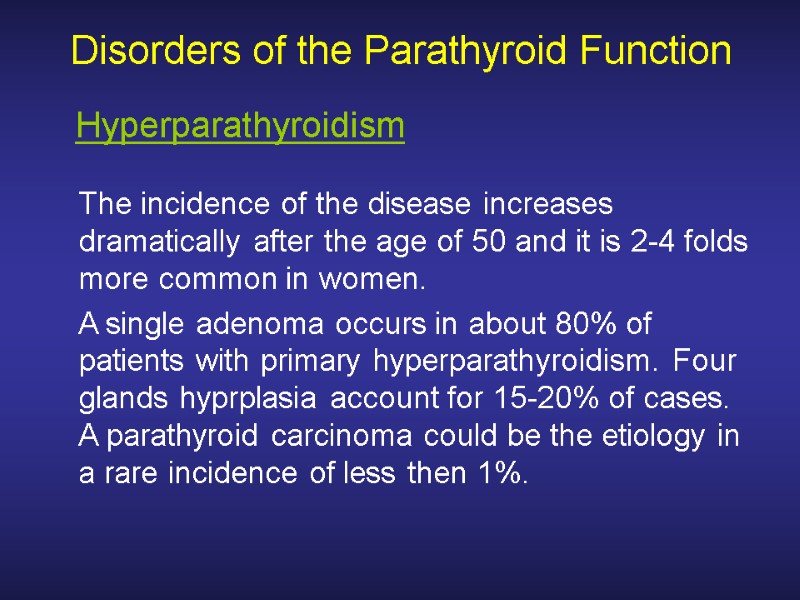





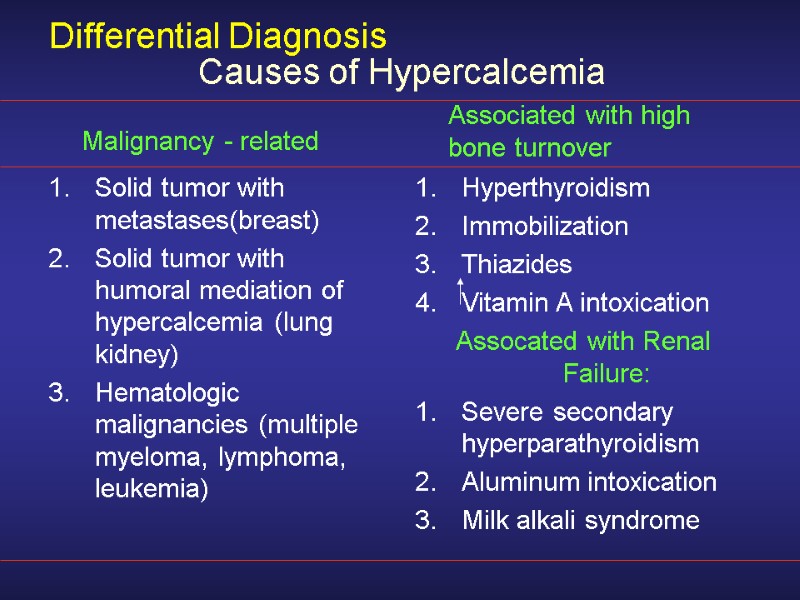



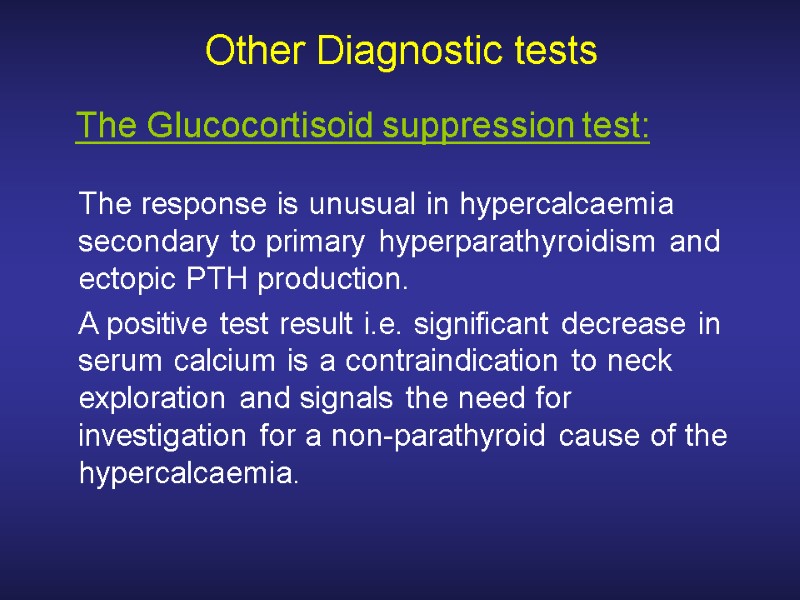
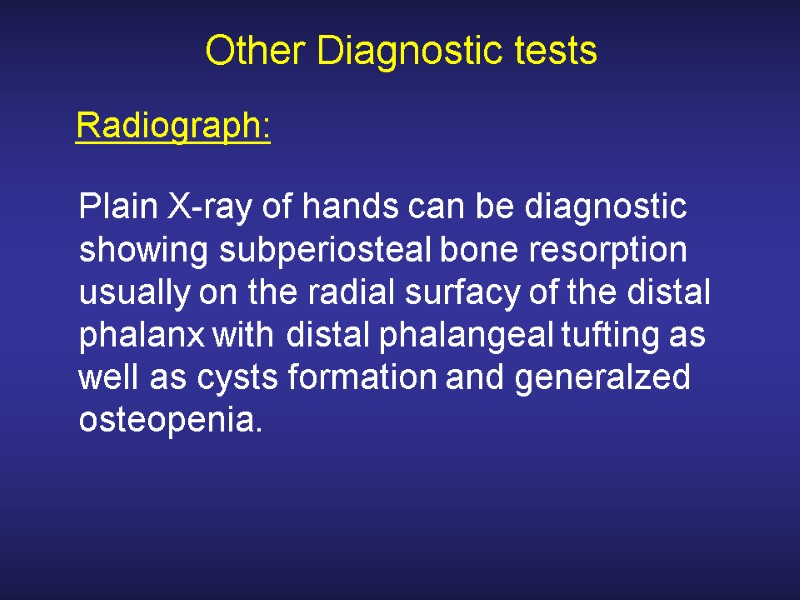




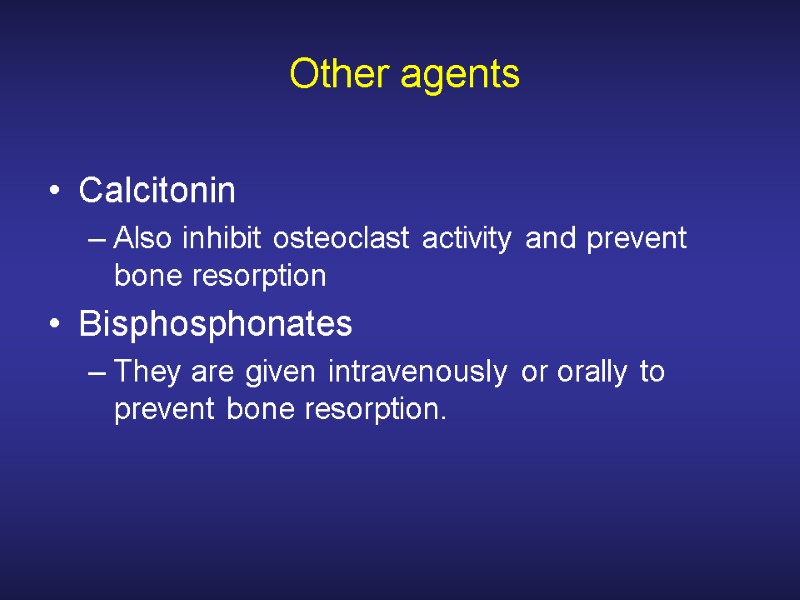

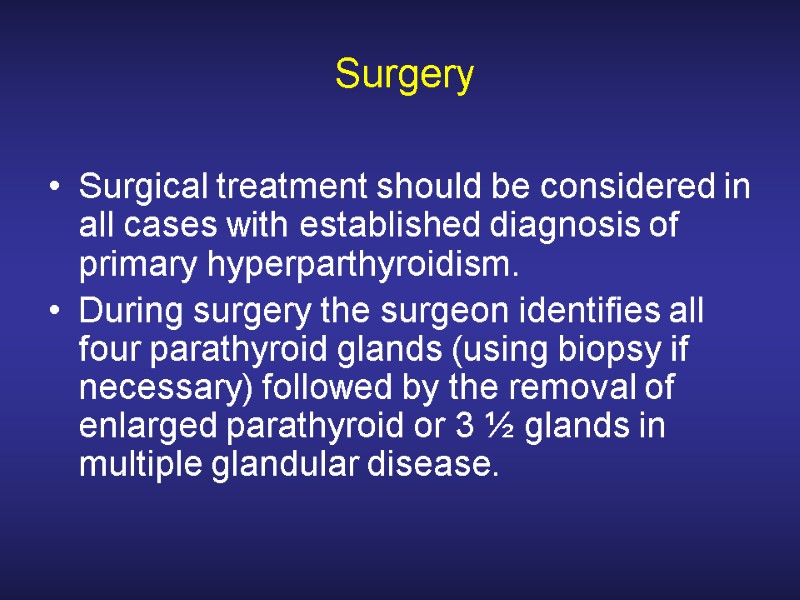






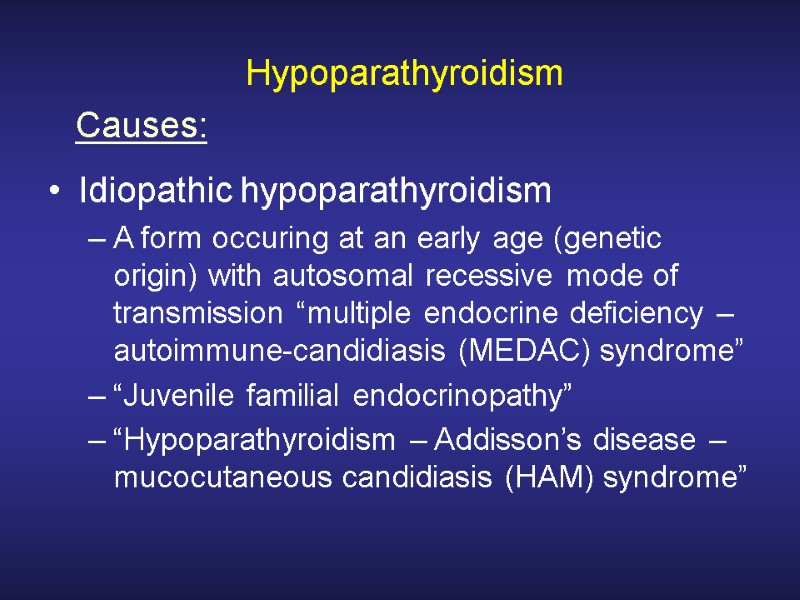












10800-disorders_of_the_parathyroid_glands.ppt
- Количество слайдов: 47
 DISORDERS OF THE PARATHYROID GLANDS
DISORDERS OF THE PARATHYROID GLANDS
 Disorders of the Parathyroid Glands Maintenance of calcium, phosphate and magnesium homeostasis is under the influence of two polypeptide hormones; parathyroid hormone(PTH), and calcitonin (CT), as well as a sterol hormone, 1,25 dihydroxy cholecalciferol (1,25 (OH)2D3.
Disorders of the Parathyroid Glands Maintenance of calcium, phosphate and magnesium homeostasis is under the influence of two polypeptide hormones; parathyroid hormone(PTH), and calcitonin (CT), as well as a sterol hormone, 1,25 dihydroxy cholecalciferol (1,25 (OH)2D3.
 Disorders of the Parathyroid Glands These hormones regulate the flow of minerals in and out of the extracellular fluid compartments through their actions on intestine, kidneys, and bones.
Disorders of the Parathyroid Glands These hormones regulate the flow of minerals in and out of the extracellular fluid compartments through their actions on intestine, kidneys, and bones.
 Disorders of the Parathyroid Glands The PTH acts directly on the bones and kidneys and indirectly on the intestine through its effect on the synthesis of 1,25 (OH)2D3. Its production is regulated by the concentration of serum ionized calcium. Lowering of the serum calcium levels will induce an increased rate of parathyroid hormone secretion
Disorders of the Parathyroid Glands The PTH acts directly on the bones and kidneys and indirectly on the intestine through its effect on the synthesis of 1,25 (OH)2D3. Its production is regulated by the concentration of serum ionized calcium. Lowering of the serum calcium levels will induce an increased rate of parathyroid hormone secretion
 Disorders of the Parathyroid Glands Calcitonin is released by the “C” cells (parafollicular cells in the thyroid gland) in response to small increases in plasma ionic calcium. It acts on the kidney and bones to restore the level of calcium to just below a normal set point which in turn inhibits secretion of the hormone.
Disorders of the Parathyroid Glands Calcitonin is released by the “C” cells (parafollicular cells in the thyroid gland) in response to small increases in plasma ionic calcium. It acts on the kidney and bones to restore the level of calcium to just below a normal set point which in turn inhibits secretion of the hormone.
 Disorders of the Parathyroid Glands Calcitonin is therefore the physiological antagonist of PTH. The two hormones act in concert to maintain normal concentration of calcium ion in the extracellular fluid.
Disorders of the Parathyroid Glands Calcitonin is therefore the physiological antagonist of PTH. The two hormones act in concert to maintain normal concentration of calcium ion in the extracellular fluid.

 Disorders of the Parathyroid Function Primary hyperparathyroidismis due to excessive production of PTH by one or more of hyperfunctioning parathyroid glands. This leads to hyprcalcemia which fails to inhibit the gland activity in the normal manner. Hyperparathyroidism
Disorders of the Parathyroid Function Primary hyperparathyroidismis due to excessive production of PTH by one or more of hyperfunctioning parathyroid glands. This leads to hyprcalcemia which fails to inhibit the gland activity in the normal manner. Hyperparathyroidism
 Disorders of the Parathyroid Function The cause of primary hyperparathyroidism is unknown. A genetic factor may be involved. The clonal origin of most parathyroid adenomas suggests a defect at the level of the gene controlling the regulation and/or expression of parathyroid hormone. Hyperparathyroidism
Disorders of the Parathyroid Function The cause of primary hyperparathyroidism is unknown. A genetic factor may be involved. The clonal origin of most parathyroid adenomas suggests a defect at the level of the gene controlling the regulation and/or expression of parathyroid hormone. Hyperparathyroidism
 Disorders of the Parathyroid Function The incidence of the disease increases dramatically after the age of 50 and it is 2-4 folds more common in women. A single adenoma occurs in about 80% of patients with primary hyperparathyroidism. Four glands hyprplasia account for 15-20% of cases. A parathyroid carcinoma could be the etiology in a rare incidence of less then 1%. Hyperparathyroidism
Disorders of the Parathyroid Function The incidence of the disease increases dramatically after the age of 50 and it is 2-4 folds more common in women. A single adenoma occurs in about 80% of patients with primary hyperparathyroidism. Four glands hyprplasia account for 15-20% of cases. A parathyroid carcinoma could be the etiology in a rare incidence of less then 1%. Hyperparathyroidism
 Disorders of the Parathyroid Function The two major sites of potential complications are the bones and the kidneys. The kidneys may have renal stones (nephrolithiasis) or diffuse deposition of calcium-phosphate complexes in the parachyma (nephrocalcinosis). Now a days such complications are seen less commonly and around 20% of patients or less show such complications. Clinical Features:
Disorders of the Parathyroid Function The two major sites of potential complications are the bones and the kidneys. The kidneys may have renal stones (nephrolithiasis) or diffuse deposition of calcium-phosphate complexes in the parachyma (nephrocalcinosis). Now a days such complications are seen less commonly and around 20% of patients or less show such complications. Clinical Features:
 Disorders of the Parathyroid Function In skeleton a condition called osteitis fibrosa cystica could occur with subperiosteal resorption of the distal phalanges, distal tappering of the clavicles, a “salt and pepper” appearance of the skull as well as bone cysts and brown tumors of the long bones. Such overt bone disease even though typical of primary hyperparathyroidism is very rarely encountered. Clinical Features:
Disorders of the Parathyroid Function In skeleton a condition called osteitis fibrosa cystica could occur with subperiosteal resorption of the distal phalanges, distal tappering of the clavicles, a “salt and pepper” appearance of the skull as well as bone cysts and brown tumors of the long bones. Such overt bone disease even though typical of primary hyperparathyroidism is very rarely encountered. Clinical Features:
 Disorders of the Parathyroid Function Now a days almost 90% of diagnosed cases in the developed countries are picked up by routine screening for calcium level using the new automated machines. Clinical Features:
Disorders of the Parathyroid Function Now a days almost 90% of diagnosed cases in the developed countries are picked up by routine screening for calcium level using the new automated machines. Clinical Features:
 Disorders of the Parathyroid Function Other symptoms include muscle weakness, easy fatigability, peptic ulcer disease, pancreatitis, hypertension, gout and pseudogout as well as anemia and depression have been associated with primary hyperparathyroidism. Clinical Features:
Disorders of the Parathyroid Function Other symptoms include muscle weakness, easy fatigability, peptic ulcer disease, pancreatitis, hypertension, gout and pseudogout as well as anemia and depression have been associated with primary hyperparathyroidism. Clinical Features:
 Differential Diagnosis Primary hyperparathyroidism Solitary adenomas Multiple endocrine neoplasia Lithium therapy Familial hypocalciuric hypercalcemia Vitamin D intoxication 1,25(OH)2D; sarcoidosis and other granulomatous diseases Idiopathic hypercalcemia or infancy Causes of Hypercalcemia Parathyroid - related Vitamin D – related
Differential Diagnosis Primary hyperparathyroidism Solitary adenomas Multiple endocrine neoplasia Lithium therapy Familial hypocalciuric hypercalcemia Vitamin D intoxication 1,25(OH)2D; sarcoidosis and other granulomatous diseases Idiopathic hypercalcemia or infancy Causes of Hypercalcemia Parathyroid - related Vitamin D – related
 Differential Diagnosis Solid tumor with metastases(breast) Solid tumor with humoral mediation of hypercalcemia (lung kidney) Hematologic malignancies (multiple myeloma, lymphoma, leukemia) Hyperthyroidism Immobilization Thiazides Vitamin A intoxication Assocated with Renal Failure: Severe secondary hyperparathyroidism Aluminum intoxication Milk alkali syndrome Causes of Hypercalcemia Malignancy - related Associated with high bone turnover
Differential Diagnosis Solid tumor with metastases(breast) Solid tumor with humoral mediation of hypercalcemia (lung kidney) Hematologic malignancies (multiple myeloma, lymphoma, leukemia) Hyperthyroidism Immobilization Thiazides Vitamin A intoxication Assocated with Renal Failure: Severe secondary hyperparathyroidism Aluminum intoxication Milk alkali syndrome Causes of Hypercalcemia Malignancy - related Associated with high bone turnover
 Diagnosis The presence of established hypercalcaemia in more than one serum measurement accompanied by elevated immunoreactive PTH is characteristic (iPTH)
Diagnosis The presence of established hypercalcaemia in more than one serum measurement accompanied by elevated immunoreactive PTH is characteristic (iPTH)
 Diagnosis Serum phosphate is usually low but may be normal. Hypercalcaemia is common and blood alkaline phosphatase (of bone origin) and the urinary hydroxyproline concentrations are commonly elevated when the bones are involved. Nephrogenous CAMP is elevated in about 80% of patients but the test is rarely used because of technical difficulties
Diagnosis Serum phosphate is usually low but may be normal. Hypercalcaemia is common and blood alkaline phosphatase (of bone origin) and the urinary hydroxyproline concentrations are commonly elevated when the bones are involved. Nephrogenous CAMP is elevated in about 80% of patients but the test is rarely used because of technical difficulties
 Other Diagnostic tests The heypercalcaemic of non-parathyroid origin e.g., vitamin D intoxication, sarcoidosis and lymphoproliferative syndromes generally respond to the administration of prednisolone in a dose of 40-60 mg daily for 10 days by a decrease in serum calcium level. The Glucocortisoid suppression test:
Other Diagnostic tests The heypercalcaemic of non-parathyroid origin e.g., vitamin D intoxication, sarcoidosis and lymphoproliferative syndromes generally respond to the administration of prednisolone in a dose of 40-60 mg daily for 10 days by a decrease in serum calcium level. The Glucocortisoid suppression test:
 Other Diagnostic tests The response is unusual in hypercalcaemia secondary to primary hyperparathyroidism and ectopic PTH production. A positive test result i.e. significant decrease in serum calcium is a contraindication to neck exploration and signals the need for investigation for a non-parathyroid cause of the hypercalcaemia. The Glucocortisoid suppression test:
Other Diagnostic tests The response is unusual in hypercalcaemia secondary to primary hyperparathyroidism and ectopic PTH production. A positive test result i.e. significant decrease in serum calcium is a contraindication to neck exploration and signals the need for investigation for a non-parathyroid cause of the hypercalcaemia. The Glucocortisoid suppression test:
 Other Diagnostic tests Plain X-ray of hands can be diagnostic showing subperiosteal bone resorption usually on the radial surfacy of the distal phalanx with distal phalangeal tufting as well as cysts formation and generalzed osteopenia. Radiograph:
Other Diagnostic tests Plain X-ray of hands can be diagnostic showing subperiosteal bone resorption usually on the radial surfacy of the distal phalanx with distal phalangeal tufting as well as cysts formation and generalzed osteopenia. Radiograph:
 Other Diagnostic tests Ultrasonography MRI CT Thallium 201 – Tehcnichum99m scan (subtraction study) Pre-operative localization of the abnormal parathyroid gland(s):
Other Diagnostic tests Ultrasonography MRI CT Thallium 201 – Tehcnichum99m scan (subtraction study) Pre-operative localization of the abnormal parathyroid gland(s):
 Treatment A large proportion of patients have “biochemical” hyperparathyroidism but with prolonged follow up they progress to overt clinical presentation. Resection of the parathyroid lesion is curative with recurrences observed mainly in the multiple glandular disease.
Treatment A large proportion of patients have “biochemical” hyperparathyroidism but with prolonged follow up they progress to overt clinical presentation. Resection of the parathyroid lesion is curative with recurrences observed mainly in the multiple glandular disease.
 Medical Treatment of the hypercalcaemia In acute severe forms the main stay of therapy is adequate hydration with saline and forced diuresis by diuretics to increase the urinary excretion of calcium rapidly along with sodium and prevent its reabsorption by the renal tubules.
Medical Treatment of the hypercalcaemia In acute severe forms the main stay of therapy is adequate hydration with saline and forced diuresis by diuretics to increase the urinary excretion of calcium rapidly along with sodium and prevent its reabsorption by the renal tubules.
 Other agents Glucocostiroids In hypercalcaemia associated the hematological malignant neoplasms Mythramycin A toxic antibiotics which inhibit bone resorption and is used in hematological and solid neoplasms causing hypercalcaemia.
Other agents Glucocostiroids In hypercalcaemia associated the hematological malignant neoplasms Mythramycin A toxic antibiotics which inhibit bone resorption and is used in hematological and solid neoplasms causing hypercalcaemia.
 Other agents Calcitonin Also inhibit osteoclast activity and prevent bone resorption Bisphosphonates They are given intravenously or orally to prevent bone resorption.
Other agents Calcitonin Also inhibit osteoclast activity and prevent bone resorption Bisphosphonates They are given intravenously or orally to prevent bone resorption.
 Other agents Phosphate Oral phosphate can be used as an antihypercalcaemic agent and is commonly used as a temporary measure during diagnostic workup. Estrogen It also decrease bone resorption and can be given to postmenopausal women with primary hyperparathyroidism using medical therapy
Other agents Phosphate Oral phosphate can be used as an antihypercalcaemic agent and is commonly used as a temporary measure during diagnostic workup. Estrogen It also decrease bone resorption and can be given to postmenopausal women with primary hyperparathyroidism using medical therapy
 Surgery Surgical treatment should be considered in all cases with established diagnosis of primary hyperparthyroidism. During surgery the surgeon identifies all four parathyroid glands (using biopsy if necessary) followed by the removal of enlarged parathyroid or 3 ½ glands in multiple glandular disease.
Surgery Surgical treatment should be considered in all cases with established diagnosis of primary hyperparthyroidism. During surgery the surgeon identifies all four parathyroid glands (using biopsy if necessary) followed by the removal of enlarged parathyroid or 3 ½ glands in multiple glandular disease.
 Other Complications Deterioration of renal function Metabolic disturbance e.g. hypomagnesia, pancreatitis, gout or pseudogout
Other Complications Deterioration of renal function Metabolic disturbance e.g. hypomagnesia, pancreatitis, gout or pseudogout
 Secondary hyperparathyroidism An increase in PTH secretion which is adaptive and unrelated to intrinsic disease of the parathyroid glands is called secondary hyperparathyroidism. This is due to chronic stimulation of the parathyroid glands by a chronic decrease in the ionic calcium level in the blood
Secondary hyperparathyroidism An increase in PTH secretion which is adaptive and unrelated to intrinsic disease of the parathyroid glands is called secondary hyperparathyroidism. This is due to chronic stimulation of the parathyroid glands by a chronic decrease in the ionic calcium level in the blood
 Major causes of chronic hypocalcemia other than hypoparathyroidism Dietary deficiency of vitamin D or calcium Decreased intestinal absorption of vitamin D or calcium due to primary small bowel disease, short bowel syndrome, and post-gastrectomy syndrome. Drugs that cause rickets or osteomalacia such as phenytoin, phenobarbital, cholestyramine, and laxative.
Major causes of chronic hypocalcemia other than hypoparathyroidism Dietary deficiency of vitamin D or calcium Decreased intestinal absorption of vitamin D or calcium due to primary small bowel disease, short bowel syndrome, and post-gastrectomy syndrome. Drugs that cause rickets or osteomalacia such as phenytoin, phenobarbital, cholestyramine, and laxative.
 Major causes of chronic hypocalcemia other than parathyroprival hypoparathyroidism States of tissue resistance to vitamin D Excessive intake of inorganic phosphate compunds Psudohypoparathyroidism Severe hypomagnesemia Chronic renal failure
Major causes of chronic hypocalcemia other than parathyroprival hypoparathyroidism States of tissue resistance to vitamin D Excessive intake of inorganic phosphate compunds Psudohypoparathyroidism Severe hypomagnesemia Chronic renal failure
 Hypoparathyroidism Deficient secretion of PTH which manifests itself biochemically by hypocalcemia, hyperphospatemia diminished or absent circulating iPTH and clinically the symptoms of neuromuscular hyperactivity.
Hypoparathyroidism Deficient secretion of PTH which manifests itself biochemically by hypocalcemia, hyperphospatemia diminished or absent circulating iPTH and clinically the symptoms of neuromuscular hyperactivity.
 Hypoparathyroidism Surgical hypoparathyroidism – the commonest After anterior neck exploration for thyroidectomy, abnormal parathyroid gland removal, excision of a neck lesion. It could be due to the removal of the parathyroid glands or due to interruption of blood supply to the glands. Causes:
Hypoparathyroidism Surgical hypoparathyroidism – the commonest After anterior neck exploration for thyroidectomy, abnormal parathyroid gland removal, excision of a neck lesion. It could be due to the removal of the parathyroid glands or due to interruption of blood supply to the glands. Causes:
 Hypoparathyroidism Idiopathic hypoparathyroidism A form occuring at an early age (genetic origin) with autosomal recessive mode of transmission “multiple endocrine deficiency –autoimmune-candidiasis (MEDAC) syndrome” “Juvenile familial endocrinopathy” “Hypoparathyroidism – Addisson’s disease – mucocutaneous candidiasis (HAM) syndrome” Causes:
Hypoparathyroidism Idiopathic hypoparathyroidism A form occuring at an early age (genetic origin) with autosomal recessive mode of transmission “multiple endocrine deficiency –autoimmune-candidiasis (MEDAC) syndrome” “Juvenile familial endocrinopathy” “Hypoparathyroidism – Addisson’s disease – mucocutaneous candidiasis (HAM) syndrome” Causes:
 Hypoparathyroidism Idiopathic hypoparathyroidism Circulating antibodies for the parathyroid glands and the adrenals are frequently present. Other associated disease: Pernicious anemia Ovarian failure Autoimmune thyroiditis Diabetes mellitus Causes:
Hypoparathyroidism Idiopathic hypoparathyroidism Circulating antibodies for the parathyroid glands and the adrenals are frequently present. Other associated disease: Pernicious anemia Ovarian failure Autoimmune thyroiditis Diabetes mellitus Causes:
 Hypoparathyroidism Idiopathic hypoparathyroidism The late onset form occurs sporadically without circulating grandular autoantibodies. Functional hypoparathyroidism In patients who has chronic hypomagesaemia of various causes. Magnesium is necessary for the PTH release from the glands and also for the peripheral action of the PTH. Causes:
Hypoparathyroidism Idiopathic hypoparathyroidism The late onset form occurs sporadically without circulating grandular autoantibodies. Functional hypoparathyroidism In patients who has chronic hypomagesaemia of various causes. Magnesium is necessary for the PTH release from the glands and also for the peripheral action of the PTH. Causes:
 Hypoparathyroidism Neuromuscular The rate of decrease in serum calcium is the major determinant for the development of neuromuscular complications. When nerves are exposed to low levels of calcium they show abnormal neuronal function which may include decrease threshold of excitation, repetitive response to a single stimulus and rarely continuous activity. Clinical Features:
Hypoparathyroidism Neuromuscular The rate of decrease in serum calcium is the major determinant for the development of neuromuscular complications. When nerves are exposed to low levels of calcium they show abnormal neuronal function which may include decrease threshold of excitation, repetitive response to a single stimulus and rarely continuous activity. Clinical Features:
 Hypoparathyroidism Neuromuscular Parathesia Tetany Hyperventilation Adrenergic symptoms Convulsion (More common in young people and it can take the form of either generalized tetany followed by prolonged tonic spasms or the typical epileptiform seizures. Signs of latent tetany Chvostek sign Trousseau sign Extrapyramidal signs (due to basal ganglia calcification) Clinical Features:
Hypoparathyroidism Neuromuscular Parathesia Tetany Hyperventilation Adrenergic symptoms Convulsion (More common in young people and it can take the form of either generalized tetany followed by prolonged tonic spasms or the typical epileptiform seizures. Signs of latent tetany Chvostek sign Trousseau sign Extrapyramidal signs (due to basal ganglia calcification) Clinical Features:
 Hypoparathyroidism Other clinical manifestation Posterio lenticular cataract Cardiac manifestation: Prolonged QT interval in the ECG Resistance to digitalis Hypotension Refractory heart failure with cardiomegally can occur. Clinical Features:
Hypoparathyroidism Other clinical manifestation Posterio lenticular cataract Cardiac manifestation: Prolonged QT interval in the ECG Resistance to digitalis Hypotension Refractory heart failure with cardiomegally can occur. Clinical Features:
 Hypoparathyroidism Other clinical manifestation Dental Manifestation Abnormal enamel formation with delayed or absent dental eruption and defective dental root formation. Malabsorption syndrome Presumably secondary to decreased calcium level and may lead to steatorrhoea with long standing untreated disease. Clinical Features:
Hypoparathyroidism Other clinical manifestation Dental Manifestation Abnormal enamel formation with delayed or absent dental eruption and defective dental root formation. Malabsorption syndrome Presumably secondary to decreased calcium level and may lead to steatorrhoea with long standing untreated disease. Clinical Features:
 Hypoparathyroidism In the absence of renal failure the presence of hypocalcaemia with hyperphosphataemia is virtually diagnostic of hypoparathyroidism. Undetectable serum iPTH confirms the diagnosis or it can be detectable if the assay is very sensitive. Diagnosis:
Hypoparathyroidism In the absence of renal failure the presence of hypocalcaemia with hyperphosphataemia is virtually diagnostic of hypoparathyroidism. Undetectable serum iPTH confirms the diagnosis or it can be detectable if the assay is very sensitive. Diagnosis:
 Hypoparathyroidism The mainstay of treatment is a combination of oral calcium with pharmacological doses of vitamin D or its potent analogues. Phosphate restriction in diet may also be useful with or without aluminum hydroxide gel to lower serum phosphate level. Treatment:
Hypoparathyroidism The mainstay of treatment is a combination of oral calcium with pharmacological doses of vitamin D or its potent analogues. Phosphate restriction in diet may also be useful with or without aluminum hydroxide gel to lower serum phosphate level. Treatment:
 Emergency Treatment for Hypocalcaemic Calcium should be given parenterally till adequate serum calcium level is obtained and then vitamin D supplementation with oral calcium should be initiated. Tetany:
Emergency Treatment for Hypocalcaemic Calcium should be given parenterally till adequate serum calcium level is obtained and then vitamin D supplementation with oral calcium should be initiated. Tetany:
 Emergency Treatment for Hypocalcaemic In patients with hyperparathyroidism and severe bone disease who undergo successful parathyroidectomy hypocalcaemia may be severe and parenteral calcium infusion with later supplementation with oral calcium and vitamin D. Hungry bone syndrome:
Emergency Treatment for Hypocalcaemic In patients with hyperparathyroidism and severe bone disease who undergo successful parathyroidectomy hypocalcaemia may be severe and parenteral calcium infusion with later supplementation with oral calcium and vitamin D. Hungry bone syndrome:
 Pseudohypoparathysoidism and Pseudopseudohypoparathyroidism A rare familial disorders with target tissue resistance to PTH. There is hypocalcaemia, hyperphosphataemia, with increased parathyroid gland function. There is also a variety of congenital defects in the growth and development of skeleton including: Short statue Short metacarpal and metatarsal bones
Pseudohypoparathysoidism and Pseudopseudohypoparathyroidism A rare familial disorders with target tissue resistance to PTH. There is hypocalcaemia, hyperphosphataemia, with increased parathyroid gland function. There is also a variety of congenital defects in the growth and development of skeleton including: Short statue Short metacarpal and metatarsal bones
 Pseudohypoparathysoidism and Pseudopseudohypoparathyroidism In pseudopseudohypoparathyroidism they have the developmental defects without the biochemical abnormalities The diagnosis is established when low serum calcium level with hyperphosphataemia is associated with increased serum iPTH as well as diminished nephrogenous CAMP and phosphature response to PTH administration
Pseudohypoparathysoidism and Pseudopseudohypoparathyroidism In pseudopseudohypoparathyroidism they have the developmental defects without the biochemical abnormalities The diagnosis is established when low serum calcium level with hyperphosphataemia is associated with increased serum iPTH as well as diminished nephrogenous CAMP and phosphature response to PTH administration

